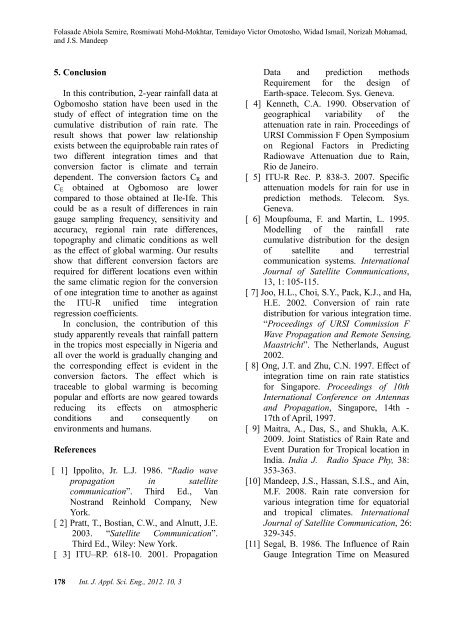Download (3001Kb) - Covenant University Repository
Download (3001Kb) - Covenant University Repository
Download (3001Kb) - Covenant University Repository
Create successful ePaper yourself
Turn your PDF publications into a flip-book with our unique Google optimized e-Paper software.
Folasade Abiola Semire, Rosmiwati Mohd-Mokhtar, Temidayo Victor Omotosho, Widad Ismail, Norizah Mohamad,<br />
and J.S. Mandeep<br />
5. Conclusion<br />
In this contribution, 2-year rainfall data at<br />
Ogbomosho station have been used in the<br />
study of effect of integration time on the<br />
cumulative distribution of rain rate. The<br />
result shows that power law relationship<br />
exists between the equiprobable rain rates of<br />
two different integration times and that<br />
conversion factor is climate and terrain<br />
dependent. The conversion factors CR and<br />
CE obtained at Ogbomoso are lower<br />
compared to those obtained at Ile-Ife. This<br />
could be as a result of differences in rain<br />
gauge sampling frequency, sensitivity and<br />
accuracy, regional rain rate differences,<br />
topography and climatic conditions as well<br />
as the effect of global warming. Our results<br />
show that different conversion factors are<br />
required for different locations even within<br />
the same climatic region for the conversion<br />
of one integration time to another as against<br />
the ITU-R unified time integration<br />
regression coefficients.<br />
In conclusion, the contribution of this<br />
study apparently reveals that rainfall pattern<br />
in the tropics most especially in Nigeria and<br />
all over the world is gradually changing and<br />
the corresponding effect is evident in the<br />
conversion factors. The effect which is<br />
traceable to global warming is becoming<br />
popular and efforts are now geared towards<br />
reducing its effects on atmospheric<br />
conditions and consequently on<br />
environments and humans.<br />
References<br />
[ 1] Ippolito, Jr. L.J. 1986. “Radio wave<br />
propagation in satellite<br />
communication”. Third Ed., Van<br />
Nostrand Reinhold Company, New<br />
York.<br />
[ 2] Pratt, T., Bostian, C.W., and Alnutt, J.E.<br />
2003. “Satellite Communication”.<br />
Third Ed., Wiley: New York.<br />
[ 3] ITU–RP. 618-10. 2001. Propagation<br />
178 Int. J. Appl. Sci. Eng., 2012. 10, 3<br />
Data and prediction methods<br />
Requirement for the design of<br />
Earth-space. Telecom. Sys. Geneva.<br />
[ 4] Kenneth, C.A. 1990. Observation of<br />
geographical variability of the<br />
attenuation rate in rain. Proceedings of<br />
URSI Commission F Open Symposium<br />
on Regional Factors in Predicting<br />
Radiowave Attenuation due to Rain,<br />
Rio de Janeiro.<br />
[ 5] ITU-R Rec. P. 838-3. 2007. Specific<br />
attenuation models for rain for use in<br />
prediction methods. Telecom. Sys.<br />
Geneva.<br />
[ 6] Moupfouma, F. and Martin, L. 1995.<br />
Modelling of the rainfall rate<br />
cumulative distribution for the design<br />
of satellite and terrestrial<br />
communication systems. International<br />
Journal of Satellite Communications,<br />
13, 1: 105-115.<br />
[ 7] Joo, H.L., Choi, S.Y., Pack, K.J., and Ha,<br />
H.E. 2002. Conversion of rain rate<br />
distribution for various integration time.<br />
“Proceedings of URSI Commission F<br />
Wave Propagation and Remote Sensing,<br />
Maastricht”. The Netherlands, August<br />
2002.<br />
[ 8] Ong, J.T. and Zhu, C.N. 1997. Effect of<br />
integration time on rain rate statistics<br />
for Singapore. Proceedings of 10th<br />
International Conference on Antennas<br />
and Propagation, Singapore, 14th -<br />
17th of April, 1997.<br />
[ 9] Maitra, A., Das, S., and Shukla, A.K.<br />
2009. Joint Statistics of Rain Rate and<br />
Event Duration for Tropical location in<br />
India. India J. Radio Space Phy, 38:<br />
353-363.<br />
[10] Mandeep, J.S., Hassan, S.I.S., and Ain,<br />
M.F. 2008. Rain rate conversion for<br />
various integration time for equatorial<br />
and tropical climates. International<br />
Journal of Satellite Communication, 26:<br />
329-345.<br />
[11] Segal, B. 1986. The Influence of Rain<br />
Gauge Integration Time on Measured
















